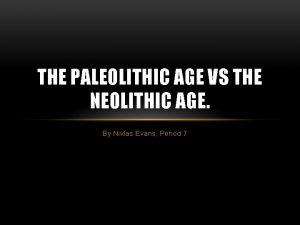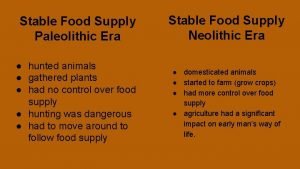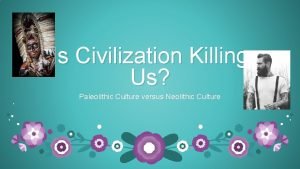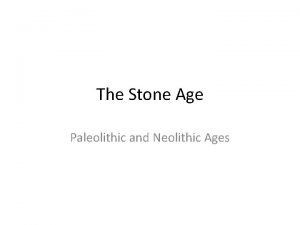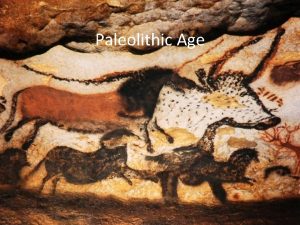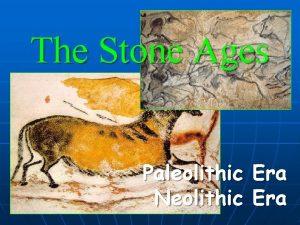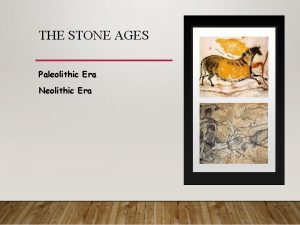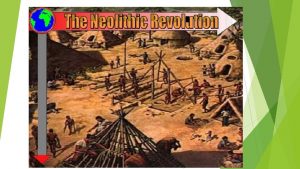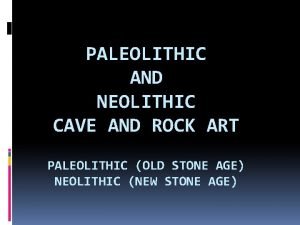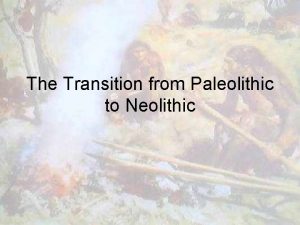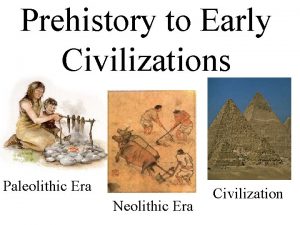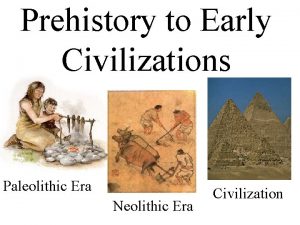Neolithic Revolution Overview Well review the Paleolithic Era















- Slides: 15

Neolithic Revolution

Overview… • We’ll review the Paleolithic Era • We’ll talk about humanity’s transition from hunting and gathering to settled agriculture (Neolithic Revolution) – Who, what, where, why, when and how? • Lasting impacts

Paleolithic Era • Also known as Old Stone Age • Began 2 million years ago • Humans during this period: – – – – Were nomadic Were hunter-gatherers Lived in small clans First to make simple tools and weapons Mastered use of fire Developed spoken language Egalitarian

Neolithic Revolution • Also known as the Agricultural Revolution • Societies move from hunting and gathering to farming • Was this mankind’s biggest mistake? ? ? – Poorer health – Shorter lifespans – Harder labor for the majority of people

Neolithic Revolution • First permanent human settlements emerged • Agricultural Revolution involved the domestication of plants and animals – Agriculturalists domesticate both – Pastoralists domesticate only animals • Literally translates to New Stone Age – still used stone tools but more refined • First permanent human settlements emerged (sedentary) • Pottery is used • SLOW transition spanning thousands of years • Less variety • Ratchet Effect – Evidence: Bantu speaking populations

“Fertile Crescent” Was First • End of last Ice Age • Started in the Fertile Crescent (modern day Iraq) – Also known as Mesopotamia – Located between the Tigris and Euphrates Rivers • Warming climate allowed for wild grasses to abundantly grow – Grasses very close to domesticated varieties we have today


How Did Agriculture Develop? • Availability of calories determines how humans get their food (dependent on local flora and fauna) • End of ice age Plants thriving • Intensification – Humans began “helping” plants along and selecting for traits with ultimate goal of increasing calories gathered • Certain plants were abundant and provided many calories Humans actively chose those


Domestication of Animals • What is it? An animal will breed where and when we want it to and often – It learns to come to us for food – It’s not aggressive • Non-Examples: Deer and Tigers

Important Domesticated Animals • • • Horses Cows Pigs Sheep Goats Chickens Oxen Elephants All from Eurasia!

What Did the Americas Have? • Guinea pigs, turkeys, and LLAMAS!!! • Some places at a disadvantage with regards to local flora and fauna For example, Highland New Guinea had no animals available to domesticate; had long-term impact on their development

Agriculture’s Impact • Sedentary lifestyle • Close-knit society and the need for cooperation & group effort • Land becomes more efficient resulting in a surplus of food • Allows for specialization, development of tools and weapons • Increased population and material possessions • New social organization – from egalitarian to social stratification (social heirarchies) • Patriarchy (Rule by males/women viewed as needing protection or control)

Was This Change for the Better? • Hunter-Gathering Societies: – More free time – Temporary shelter – Small Groups (less conflict) – Public land • Agricultural Societies – Constant work but food source more reliable – Long-term homes – Larger groups (more conflict; disease) – Private land – Negative Environmental Impact – More stability

Just a Friendly Reminder… • To prepare for our next class, please read pages 36 – 48 in your textbook. Do your homework. Dragons aren’t real.
 Paleolithic mesolithic neolithic art
Paleolithic mesolithic neolithic art Similarities of paleolithic and neolithic
Similarities of paleolithic and neolithic Neolithic art vs paleolithic art
Neolithic art vs paleolithic art Paleolithic vs neolithic
Paleolithic vs neolithic Paleolithic food supply
Paleolithic food supply Paleolithic versus neolithic
Paleolithic versus neolithic Neolithic health
Neolithic health When was the paleolithic era
When was the paleolithic era The old stone age
The old stone age Scrapers stone age
Scrapers stone age Paleolithic era definition
Paleolithic era definition What are the characteristics of the paleolithic age
What are the characteristics of the paleolithic age Mesolithic era nutrition
Mesolithic era nutrition Characteristics of new stone age
Characteristics of new stone age Neolithic era characteristics
Neolithic era characteristics Jericho and aleppo
Jericho and aleppo



